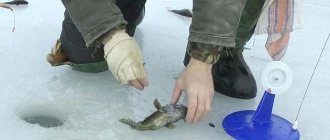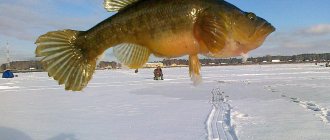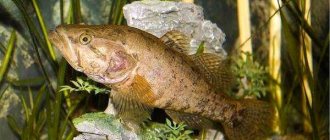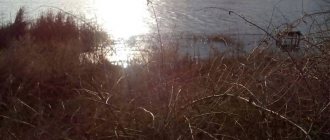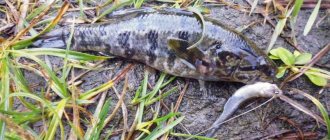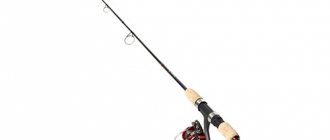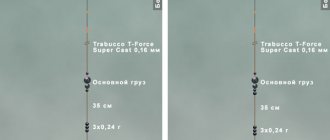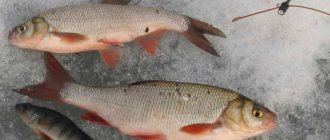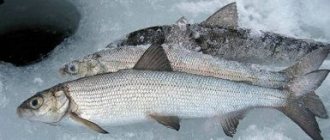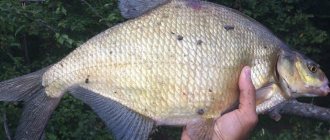Features of catching rotan using a spinning rod
Even if the reservoir is heavily silted, or is located in an urban area where no one is simply able to survive because of the garbage, rotan can calmly live there, feed and reproduce. For this reason, he is very loved by fishermen, who do not always have enough time in their lives to travel outside the city to fish on the shore.
But be prepared for the fact that debris and grass will end up on your line, which means you will have to remove them from the line.
Rotan weighing from one hundred grams to a kilogram can be caught using a spinning rod.
If there are shuks in the reservoir, then there is no point in looking for rotan in the vicinity. He bypasses the territory of the toothy predator a mile away. But if there are few large predators, the population of this fish grows noticeably, simplifying your search task.
Another advantage of rotan is that it is not picky about food. It bites on pieces of meat, ordinary worms, and lard. In general, food of animal origin. So chicken that has been stale for a couple of weeks can be an excellent treat for him. You can catch big fish with live bait. He is often well caught on local river fish, which are part of his natural diet, and does not arouse any suspicion.
Note to the fisherman! Rotan often hides in ambushes. They can serve as any, even small shelters. He does this not because he is afraid of anyone. On the contrary, these are his hunting methods, allowing him to attack quickly and unexpectedly. Exhaustive pursuit of prey is not for him. Therefore, a fast-moving spinning bait will not arouse his enthusiasm at all.
The fish is known for its gluttony. She can pounce on prey and tear it with her teeth, no worse than some tropical piranha.
Read more:
Carp fishing
Why edible rubber and a little about the habits of rotan
Rotan is a “lazy predator”. He does not hunt for his prey, does not catch up with it, does not drive the whole flock into a corner, as perches do. He simply does not swim too quickly to the weakened fish, and then simply grabs it and eats it. Often prefers worms, frogs, water beetles - any available prey, hunting for which does not take too much effort.
Its bite is quite peculiar. It does not take the bait with a blow, like a chub, asp or pike perch, and does not immediately drag it to the side into the grass, like a pike. He just stops in place and starts chewing. Its taste buds and sense of smell are much more involved in the search for food than the lateral line, vision and other senses. You need to carefully watch the tip of the rod, when it shows that the fish has landed - wait a little so that it begins to chew gum, and only then hook it.
You won't be able to deceive him with a piece of iron or a piece of plastic - he will immediately spit out the bait without feeling anything edible. He will rarely be detected on them. Therefore, fishing with edible rubber is one of the few reliable ways in which you can catch it . Contrary to misconceptions, this fish is quite careful. Often you have to make several trips to the same place before a bite follows. You have to change baits and try different techniques. In general, catching it with a jig requires skill, attention, and knowledge of the game of the rubber bands that you use.
Rotan does not like to stay in open places and avoids areas well lit by the sun. It should be caught near grass, snags, and the edges of bushes, placing the bait near the shore, from which a shadow falls on the water. There is no clear depth where it can be caught - it can bite at a depth of six meters or near the surface. Use different retrieving and casting techniques to find the big fish.
Spinning rod equipment for catching rotan
There is no point in taking heavy fishing rods for rotan. The ideal option for us is ultralight spinning rods with a test weight of up to ten grams. Take a sensitive rod, because you shouldn’t expect strong bites from this fish. Fishing takes place vertically. In the thickets they find a window into which the bait is thrown.
What to catch? The bait is often taken in a variety of ways. This could be a small silicone worm, a wobbler, or a jig head. Someone should try catching rotan using drop shots.
We'll start with jig baits. They, like twisters, are light (weighing up to five grams). The cast is meant to be not too far, close to the fish location area.
For example, we cast about thirty centimeters away, gently lower the bait and begin to bring it towards the fish. Don't expect a bite right away. From the second or third time, Rotan gets used to the idea that everything is in order and attacks. A flavored silicone worm should have a taste. Because the fish will not chew a tasteless piece of rubber.
The following option is often used. First, attention is attracted with the help of a minnow. But it is too big for this small fish. Therefore, the bait is immediately changed to an ultra jig. The casting distance is not important here at all. Fish even close to the shore. Rotan comes as close as possible without fear. Wobblers are less effective in this regard, although they also catch fish.
To the winter camp
For this gear, live bait is used as bait. This could be a fry of any other fish or a smaller specimen of the rotan itself. Fishing is carried out according to the matryoshka principle
. If you attach an individual weighing 30 g, you will be able to catch a firebrand weighing 50 g, then it can be used as live bait for a predator weighing 70 g, and so on in increasing order.
Expert opinion Valery Andreevich Sizov Fisherman professional with 35 years of experience
For reference! There are two types of vents - above-ice and under-ice. The first type is the most common. The simplest options consist of a twig installed on the ice, a fishing line with equipment and a rag as a signal flag. More complex installations have a coil and a special signaling device with a flag. The second type is equipped with a forest clearer (for example, a hand-made wooden slingshot). It is tied to a horizontal board and left in this form for several hours or even overnight.
Zherlitsy can be purchased at a fishing store. However, during winter fishing, several holes are made at once, in each of which it is advisable to place this equipment. It is too expensive to buy such a number of installations, but there is a way out. You can make a zherlitsa with your own hands.
How to make a winter vent yourself
To make a zherlitsa, you don’t need to buy anything special. All materials can be found in the garage, at the dacha or in the shed: pieces of plastic, empty spools of fishing line, parts from a children's construction set, rubber plumbing gaskets, metal-plastic pipes, bolts, nuts, springs, etc.
Step-by-step process for making the stand on which the reel is held:
- Cut a small piece from the metal-plastic pipe and secure it to the top of the reel with bolts.
- To ensure that the reel rotates easily, but at the same time slows down a little during a sharp bite, install a water seal on the fastener.
- Drill a hole for the fishing line 3-4 cm below the reel.
How to make a flag:
- Take a spring (about 50 cm), for example, you can break the one in the army cap into two parts. The result will be material for 2 vents at once.
- Cut flags from bright fabric and glue them to the spring.
- If there are no suitable materials, then this element costs about 30 rubles in a fishing store.
- Any suitable groove can be used to attach the spring to the base. For example, old terminals that were used in radio equipment during the USSR.
How to make a base:
- From a piece of plastic (can be metal), cut a circle or square with a diameter/diagonal of 18 cm.
- Make holes for attaching the rack and spring with a flag.
Step by step assembly:
- Insert the metal-plastic piece into the hole.
- Attach the spring (in place with the terminal) to the base.
- The spring should bend in the form of an arc and rest freely on the coil. As soon as it starts spinning, the flag will rise.
- Wind the fishing line onto the bobbin.
- Pass the line through the hole in the pipe.
- Draw it inside to the bottom outlet and pull it out to the required length.
- Place a hook on the end of the fishing line, a little higher than the weight.
- Place plumbing gaskets in place where the pipe passes through the base to secure it.
Rice. 4. What the final result will look like after installation.
Useful recommendations when making a girder
The zherlitsa allows you to get a good catch without putting in a lot of effort. The following recommendations will help make it even more effective:
- the flag should be bright (for example, red or orange) and large in size (30-40 cm) so that it can be seen from afar;
- choose plastic reels so that they spin easily and the line does not get tangled;
- the hook can be left bare, but it is advisable to attach pieces of meat, poultry, fish, lard, etc. to it;
- if it is assumed that in the future the girder will be installed at different depths, then wind the fishing line onto the reel with a reserve;
- You can install one or two hooks, but the second option is preferable; the predator will definitely not break loose.
Read DIY PVC boat awning
As it became clear, for winter catching rotan you don’t need to buy any very expensive gear. The simplest fishing rod and homemade fishing rods will be enough. It is recommended to use these two tackles in tandem. That is, in one hole, catch a predator with a fishing rod, and place donks in the rest. This will allow you to catch more fish and spend less fish on it.
Also on this topic:
Spinner for rotan in winter - choice of tackle and bait
Fishing for rotan in November - choosing bait and the best places for fishing
Fishing for rotan in the fall: what is better to fish for a mega catch?
Catching rotan on the first ice: where to look for a predator and at what time, gear, bait, fishing tactics
Bait for rotan - the best bait for a super catch
Fishing tactics
What is the most important thing in spinning fishing for rotan? If you have decided on the bait, then the next step is wiring.
We try to traditionally start with a stepwise approach. Our tactics will be simple. First, we wait for the sinker to fall to the bottom. Then you need to make a small jerk, after which the coil winds three or four turns. We stop and play with bait. Swing the rod with a high amplitude, alternating this with more sudden movements.
We also try to microjig in waves, being about twenty centimeters from the fish.
Two or three such casts and the fish loses its head, starting the hunt for bait. A silicone worm is also good in this regard. It is strung through the middle. It often happens that the bite occurs right while diving into the water.
Note to the fisherman! Choose a color depending on the pollution of the reservoir. The more turbid the water, the brighter the bait is needed. Often, instead of standard brown and red shades, it is worth taking orange and pink. They are more noticeable for rotan. As for the use of leashes when fishing, practice has shown that they do not have a significant effect.
The drop shot shows an excellent level of efficiency. This is a good option for long casting. And even a small stick can be used as a load. This bait will help solve problems in cases where everything around is very overgrown, there are large snags and other obstacles. We take the weight of the load small, otherwise the bait will fall through sharply
Read more:
Fishing for taimen
Wiring is always slow. First you drive smoothly, then jerk. Otherwise, you can scare away the rotan, who simply will not believe in the game.
Lures - choose edible rubber
As already mentioned, edible rubber for rotan fishing is the best choice. Made from edible rubber, rotan confidently takes on twisters, vibrating tails and worms. Twisters drive slower, vibrating tails drive faster. Worms require the slowest wiring - it’s generally better to twitch them, sharply tugging them towards the surface and letting them drop all the way down. This wiring allows you to fish all water horizons and quickly determine where the fish are holding.
Edible octopuses showed a negative result. For some reason, rotan does not like this type of rubber, but in your pond it may be catchy. It is caught quite well with crustaceans and cuttlefish.
The size of the bait should be small. The usual weight of caught fish will be from 200 grams to half a kilogram, rarely up to a kilogram. Although this fish has a large mouth, it cannot swallow large baits while moving - it takes time to open its mouth well. The size of baits is up to 5 cm; larger ones are used only when hunting for trophy fish.
Where and when is the best time to catch rotan?
If you are going fishing in the spring, then you should do it in the morning. Stock up on 2-3 cm of spinners, or make a little more from foil yourself. Place a tee, a sinker and take fresh meat for the bait. If you fish with a worm, the catch will be small. The fish is so omnivorous that it can even be caught for the meat of its own kind.
In the fall, catch windows in the grass. And as soon as the temperature begins to drop noticeably, look for rotan in the pits. Then it is most effective to fish with a long, preferably seven-meter fishing rod. At this time, it bites well on large worms and fry.
It is worth recognizing that catching rotan has never been one of the difficult tasks. Especially in those reservoirs where this fish is found in large quantities. If you have a little patience, you can safely count on pulling out a fish weighing 800 grams, or even more. Or medium size, but a lot. You won't have to wait too long.
Rod, line and reel
As you already understood from the previous paragraph, catching rotan on rubber with an ultralight spinning rod is fraught with many difficulties. It is optimal to use a rod with a fast action, with a test weight of 10-30 grams . This is the average “weight” category for spinning rods. The weight of the Tyrolean is selected based on the fishing conditions, and usually it is in this range.
You will have to throw equipment, the length of which ranges from 50 cm to 1.5 meters. It is within these limits that the hook with the elastic band from the load is located. As you understand, you need to cast a spinning rod with a large overhang of line. Often you will have to use a pendulum cast. Moreover, fishing is carried out from the shore, in difficult conditions, and you have to throw it through windows between aquatic vegetation. The length of the rod should be large, about 2.5-3 meters. Rods that are too long also have disadvantages - the banks of ponds are in most cases overgrown, and it may be impossible to cast with a spinning rod that is too long. The action must be fast - the very nature of jig fishing and the rotan bite require this. Take a carbon rod - you can't go wrong.
An inexpensive Akara Erion Jig Spin IM9 carbon fiber rod allows you to fish “through the grass” and cope with a predator of any size, test 10-30 g.
There are no special requirements for the reel - it must match the weight of the load, allow you to reel in the line at a speed sufficient for your rubber bands and start up quickly. If it is possible to use a multiplier, it is better to use it rather than an inertia-free one. Take a regular size spinner - about 2500.
This fishing is an excellent training ground for those who are used to fishing with a “wheel”, that is, with inertial reels. The weight of the equipment allows you to throw with inertia, they start almost instantly, unlike inertia-free ones, and they cost much less than multis. Of course, fans of inertia rods with antediluvian aluminum rods will have less chance of fishing than with a normal carbon whip of the required length.
Line or cord? The cord allows you to better feel the bite and wiring of the equipment. The line is less noticeable in the water and cuts less on the grass. Considering that the cord can even cut sedge, as well as some other aquatic plants, and the fishing line will slide along them, it is better to use a fishing line for such fishing. Don’t take the cheapest one; a good fluorocarbon with a thickness of 0.2 mm or more is best. There is no point in using one that is too thin - you will not be able to release it if it gets caught on the grass. If you can’t buy flurik, take a low-stretch line. The fishing distance here is rarely higher than 40 meters, and the fishing line will show the fish and the action of the bait well.
On a float rod
The tackle is no different from a float rod for crucian carp or roach. But there is a difference in the approach to fishing.
- You only need to use animal bait - preferably a chopped worm or some pieces of meat;
- you need to fish 20 cm from the bottom;
- be sure to play with the bait, twitching the tip of the rod, this is what irritates the rotan and it grabs the bait;
Let's sum it up
Fishing with a drop shot is another improvement in spinning gear. We are all once again convinced that you can catch almost any fish with a spinning rod, the main thing is to have the right approach to it. If the rotan does not agree to take your bait, try a smaller twister, change the place of fishing. You can also try using real worms as bait. This type of equipment can also be used to catch other predatory fish, including a relative of the rotan, the goby, which is widely represented in the Volga and other rivers.
Weaknesses and strengths of the tackle
Fortunately, the number of pros outweighs the number of cons of dropshot gear. Let's look at them.
Advantages
Pros of the gear:
- the bait is well accessible for attack by aquatic inhabitants;
- the nozzle can be kept in the catchable zone of the reservoir for a long time;
- wide range of applications (on currents and in still water, you can catch snags, water lilies and other habitats of various fish);
- low probability of snags;
- the ability to use different ways of playing.
Flaws
There are two disadvantages here:
- you need to constantly maintain the angle between the fishing rod and fishing line;
- tying hooks is done using one knot.
Advantages and disadvantages
3
A drop-shot rig can be the main fishing tool in a spinning angler’s arsenal or serve as an additional rig, a kind of plan “B” in case the predatory inhabitants of the reservoir begin to act up. He has a number of positive qualities that can “dispel boredom” while fishing, making it exciting and productive. These include:
- the ability to play at one point, without moving - “stomping” in place will provoke a predator faster than a fast-swimming bait;
- high efficiency against sluggish predators - bait offered in this way will not be ignored even by well-fed and passive predatory fish;
- cross-country ability - this installation allows you to fish in the toughest waters;
- compatibility with all types of silicone baits - you can fish with silicone baits of any shape and size;
- ease of assembly - the drop-shot can be quickly mounted on the shore or in a boat;
- saving money - all equipment elements cost mere pennies, but even here there is an opportunity to save money, for example, casting the sinker yourself.
Unfortunately, the equipment has one very significant drawback, which significantly limits the range of its applications. As mentioned above, a drop shot is more suitable for fishing in a vertical plane at great depths. For example, from a boat or standing on a high bank. But fishing from a flat bank, and even at shallow depths, in most cases turns out to be ineffective.
In addition, the drop shot loses its relevance on large bodies of water that have not yet been tested (unfamiliar). To quickly survey large areas and search for a feeding predator, it is more advisable to use classic equipment.
Installation of equipment
Making a drop-shot rig is not difficult at all; you can do it right on the pond; you will spend no more than 3-5 minutes on installation.
Sinker
A sinker is attached to the end of the fishing line (usually not a very large size, so as not to collect a large amount of grass and debris from the bottom, and also rises easily with the slightest tension on the fishing line). Ideal size up to 10 grams.
Hook and knot for tying
Higher up the fishing line, 20-40 cm, a hook (regular or offset) is tied directly to the main fishing line.
The size of the hook should be commensurate with the bait, and tying the hook is not difficult.
You can use absolutely any knot, it will not come apart, because both of its ends go in different directions (to the sinker and to the rod). A double loop (shown in the first picture) or double loop works well. It is noteworthy that the hook can be hung both before attaching the sinker and after that.
Lures
The bait we need (twister, rubber squid or worm) is attached to the hook.
Spoons, wobblers and other baits are not suitable for drop shots.
But using a tee instead of a regular single hook is possible. Although it is justified only in places with a rocky or sandy bottom, where the surface is not heavily clogged with vegetation.
Brief description of the fish
Rotan is a small predatory fish belonging to the firebrand family. It has a large head and a knitted cylindrical body and is covered with dense scales, which are dirty green or even dark brown in color.
Rotan is very voracious, but during its life it is not able to grow to any impressive size. On average, in many reservoirs, anglers come across specimens ranging from 100 to 300 grams. It is less common to catch heavier specimens. Some sources contain information about the harvested trophy weighing 1 kg 300 grams.
Photo 1. This rotan weighed 225 grams.
The Chinese sleeper reaches sexual maturity in the third year of life. It spawns in one go, laying eggs on bottom debris, branches, last year's foliage and vegetation. The laid clutch, which usually consists of only a few hundred eggs, is protected by the male from the encroachments of “lovers of easy money”, which ensures the survival of the species.
Rotan appeared in the USSR back in the late 1940s. Then it was imported as an aquarium fish, called the Amur goby. It quickly gained popularity because it easily survived in difficult conditions and ate almost anything. Then, apparently, someone thought of releasing it into a wild reservoir, where it did not die, and then gradually spread throughout the country.
What does it eat?
Rotan is an omnivorous underwater inhabitant that is voracious and ready to grab everything that comes in its way. This is probably why it has spread so widely, completely displacing native fish species in some reservoirs. The basis of his diet consists of:
- benthic invertebrates;
- insect larvae;
- small crustaceans and molluscs;
- caviar of other fish;
- whitebait;
- various food waste entering the reservoir.
Such gluttony and insatiability of rotan contributes to its being actively caught with a spinning rod, which is what many fishing enthusiasts do when they find themselves in reservoirs inhabited by this representative of the ichthyofauna.
How to catch a large rotan
If you are targeting a large fish, then you should use slightly different tactics. For example, a traditional worm is unlikely to help here. Because even a bunch of worms can attract small individuals that will not lag behind and will pinch the bait into small pieces, leaving no interesting bait for large fish. In order to catch a large rotan, you should use fresh beef meat as bait, which is cut into small strips, the thickness and length of a 2-ruble coin. Its shape can be either rectangular or square. The main thing is that the thickness is no more than required. It’s good if there are veins in the beef meat. The bait is hooked onto a hook, piercing it right in the middle. If there is liquid, then the hook should go through it. An additional piece of beef is threaded onto the spoon. There is no need to stock up on such attachments in large quantities, because 4-5 such pieces will be enough, since rotan will not be able to swallow them. He took the fish off the bait and continued fishing with it. The pieces will yield a catch even when they are covered with a white coating - do not rush to throw them away.
We periodically use the game of bait. The fish bites quite sharply, but does not tug the bait itself much. As soon as the nod freezes and becomes slightly larger than usual, you can immediately make a hook. The predator is attracted by the aroma of beef meat and the curious play of the bait. If you managed to catch several large specimens, then it makes sense to change the location, since there is a high probability that only small fish will continue to attack. Fishermen manage to catch trophy specimens throughout the spring, but March is a particularly good period for this.
